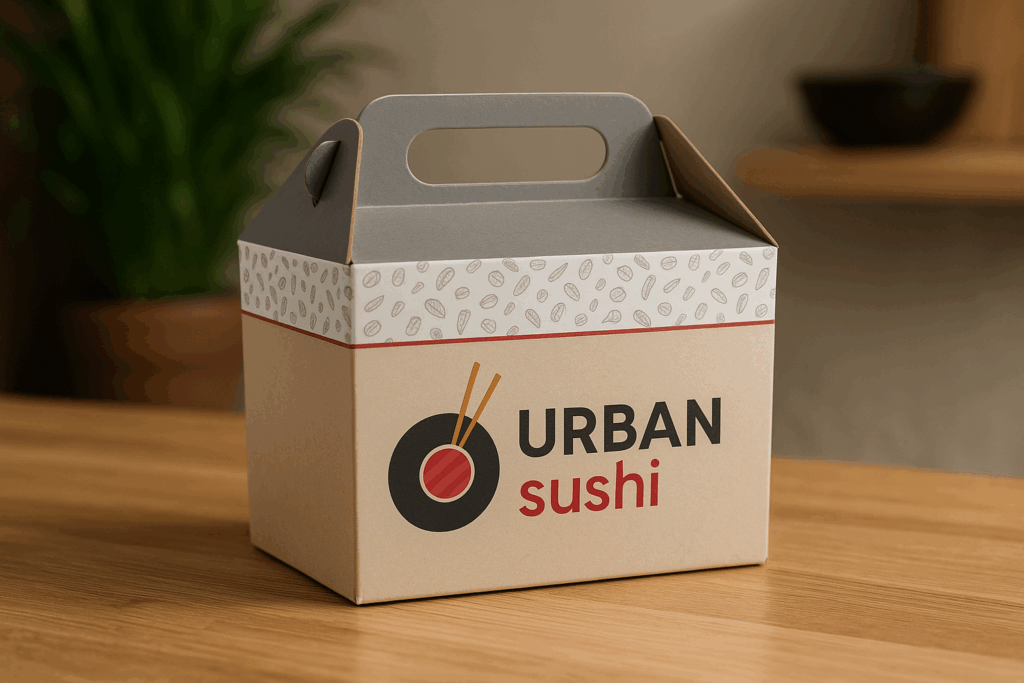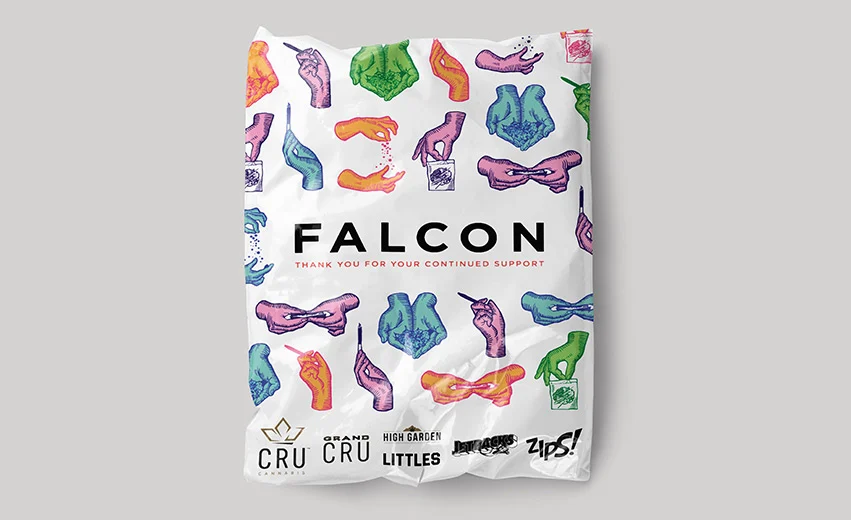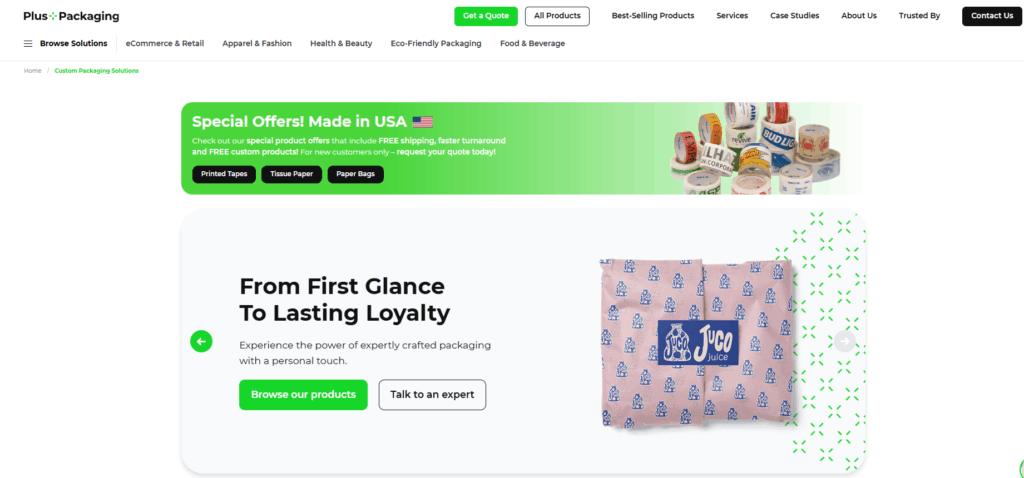Picture this: A customer eagerly awaits the arrival of something they ordered from your store. The package finally arrives, but it’s in a plain, flimsy mailer that’s torn at the corner. The product inside is fine, but that first impression? Not great.
That moment, when your customer first holds your package, matters more than you might think. It’s not just about getting products from point A to point B anymore. Your packaging is the first physical “hello” from your brand, and it can either start the relationship off right or leave customers feeling underwhelmed.
In this guide, we’ll look at how packaging choices affect what customers think about your business, how they impact your bottom line, and what you can do to make sure your packaging helps rather than hurts your brand. Because sometimes the things that seem small, like the box or mailer you choose, can make the biggest difference.
Packaging: The Silent Salesperson in Your E-Commerce Business
When you run an online store, your products don’t get the luxury of sitting on a shelf where customers can pick them up, feel their weight, or examine their quality before buying. Instead, that first physical interaction happens when your package arrives at their door.
This makes your packaging incredibly powerful—it’s essentially doing the job of your storefront, your product display, and your sales team all at once. It’s the bridge between the digital shopping experience and the physical product.
Good packaging does several critical jobs for your e-commerce business:
- It protects your products during shipping. This is the obvious function, but it’s fundamental. Products that arrive damaged create immediate disappointment and costly returns.
- It builds trust in your brand. When a package arrives intact, professionally presented, and as expected, it tells customers they made a good choice trusting your business.
- It creates a memorable moment. The physical unboxing is your chance to create a sensory experience that online browsing simply can’t provide.
- It encourages repeat purchases. Customers who have a positive unboxing experience are more likely to order from you again—and packaging plays a huge role in that decision.
- It generates word-of-mouth marketing. Distinctive packaging gets noticed, remembered, and often shared with others, extending your marketing reach.
For e-commerce businesses, packaging isn’t just a practical necessity—it’s a marketing tool, a brand builder, and a customer retention strategy all wrapped into one. The right packaging doesn’t just deliver your product; it delivers on your brand promise.
What Customers Really Want from Your Packaging
You might think customers only care about what’s inside the box, but research tells a different story. The packaging itself has become a crucial part of the buying experience—one that influences everything from initial purchase decisions to long-term brand loyalty.
Recent studies from trusted market research firms have uncovered some eye-opening statistics about how packaging affects consumer behavior and business results:
- 40% of online shoppers say they’re more likely to buy from a brand again if it comes in premium packaging
- 72% of Americans say packaging design influences their purchasing decisions
- 30% of businesses report an increase in revenue after improving their packaging
- 65% of consumers have shared pictures of interesting packaging on social media
- 80% of consumers have discovered a new product because of packaging they noticed
What does this mean for your business? Simply put, packaging isn’t just a cost—it’s an investment that can drive repeat purchases, word-of-mouth marketing, and even help you stand out from competitors. When someone gets a package that looks and feels special, they remember it. And they tell others about it.
The Customer Journey Starts with the Box
Think about the last time you ordered something online. Before you even saw the product, you interacted with the packaging. You picked it up from your doorstep, carried it inside, and opened it. That whole experience—from first touch to final unboxing—shapes how you feel about what’s inside.
For e-commerce brands especially, the package replaces the in-store experience. There’s no friendly sales associate, no chance to try before you buy. The package is your store, your brand ambassador, and your chance to make a good first impression.
“Customers form their first impression of a product’s quality within 7 seconds of seeing its packaging,” according to research from the Paper and Packaging Board. That’s not much time to make your case.
This matters for B2B shipments too. A business client receiving supplies or materials in damaged or plain packaging might question your professionalism or attention to detail—even if what’s inside is perfect.
6 Warning Signs Your Packaging Might Be Hurting Your Brand
1. Too Much Packaging Waste
When customers open a small item wrapped in layers of plastic, stuffed in a box twice its size, filled with non-recyclable packing peanuts—they notice. And they’re not impressed. Excessive packaging doesn’t just waste materials; it signals to customers that your brand isn’t thinking about its environmental impact.
One customer shared on Twitter: “Ordered a phone case that could have fit in an envelope. Got a box big enough for shoes, filled with plastic air pillows. Won’t order from them again.” That’s a lost customer over something completely avoidable.
2. Hard to Open or Handle
We’ve all been there—fighting with impossible-to-open plastic clamshells or packages sealed so thoroughly you need scissors, a knife, and possibly a blowtorch to get inside. This “wrap rage” creates a negative experience right when customers should be feeling excited about their purchase.
A study by Packaging Digest found that 80% of consumers have experienced frustration with hard-to-open packaging, and 40% have actually hurt themselves trying to open packages. That’s not the association you want with your brand.
3. Inconsistent or Bland Branding
Plain brown boxes or generic poly mailers are missed opportunities. When your packaging looks exactly like everyone else’s, you’re not reinforcing your brand identity or creating recognition.
Think about how you feel when you see an Amazon package on your doorstep versus a plain brown box. One immediately tells you what it is and creates anticipation. The other could be from anyone.
4. Frequent Product Damage
Nothing says “we don’t care about quality” like products that arrive damaged. If your items regularly show up broken, crushed, or otherwise harmed, customers won’t blame the shipping carrier—they’ll blame you.
A survey by Shorr Packaging found that 73% of consumers are less likely to purchase from a brand again if their product arrives damaged. That’s a huge hit to customer retention over something that proper packaging could prevent.
5. No Emotional Impact
Functional packaging gets the job done, but memorable packaging creates feelings. When there’s nothing special, surprising, or thoughtful about your packaging, you miss a chance to connect with customers on an emotional level.
Brands like Apple have built their reputation partly on packaging that feels special to open—creating a sense of value and anticipation that plain packaging simply can’t match.
6. No Thought to Sustainability
Today’s consumers care about the environmental impact of their purchases. When your packaging screams “landfill bound,” environmentally conscious customers take notice—and not in a good way.
A study by CGS found that 68% of consumers consider sustainability important when making purchases. Using non-recyclable materials or excessive packaging tells these customers your values don’t align with theirs.
The Business Cost of Poor Packaging Decisions
Bad packaging doesn’t just disappoint customers—it costs you money in ways you might not have considered:
- Higher return rates: When products arrive damaged due to inadequate packaging, returns increase. Each return costs an average of $10-$20 to process, not counting the lost sale and customer goodwill.
- Lower customer lifetime value: Customers who have a negative packaging experience are less likely to come back. If your average customer is worth $200 over their lifetime, losing them after one purchase means missing out on most of that value.
- Missed social opportunities: Great packaging gets shared. Boring or bad packaging doesn’t. Those social shares are essentially free marketing you’re missing out on.
- Reduced word-of-mouth: People talk about standout experiences, both good and bad. Poor packaging can turn potential advocates into critics.
Packaging Functionality and Convenience for Consumers

Good packaging isn’t just about looks—it’s about how it works for your customers. Functionality matters just as much as appearance.
Think about how your customers actually use your packaging:
Is it easy to open? Packages that require tools or excessive force create frustration right when customers should be feeling excited.
Does it protect the product properly? The primary job of packaging is protection. If it fails at this, nothing else matters.
Can customers reuse or repurpose it? Boxes or mailers that can be used for returns or storage add value beyond the initial unboxing.
Is it sized appropriately? Right-sized packaging feels thoughtful and wastes less material.
One customer shared: “I ordered earrings that came in a beautiful little box I now use for travel. Every time I use it, I remember the brand.” That’s packaging that continues to work for your brand long after delivery.
Plus Packaging’s poly mailers, for example, include tear strips that make opening easy without scissors, while their custom boxes come in sizes that minimize waste while maximizing protection. These small functional details make a big difference in how customers experience your brand.
Unboxing Experience and Its Influence on Customer Satisfaction
The “unboxing experience” has become so important that there are millions of unboxing videos on YouTube with billions of views. People don’t just want the product—they want the experience of discovering it.
A great unboxing experience includes:
- Thoughtful presentation: How the product is arranged and revealed matters. Tissue paper, custom inserts, or a particular way of folding creates anticipation.
- Sensory elements: The feel of the materials, the sound of opening the package, even scented elements can create a more memorable experience.
- Unexpected touches: Small surprises like stickers, samples, or handwritten notes make customers feel special.
- Information and guidance: Instructions, care guides, or suggestions for use help customers get the most from their purchase.
One small candle company increased their repeat purchase rate by 40% simply by switching to branded boxes with custom tissue paper and adding handwritten thank-you notes. The product didn’t change—just the experience of receiving it.
Remember that customers associate packaging quality with product quality. Premium-feeling packaging makes the product inside seem more valuable, even if nothing else has changed.
Personalization and Customization in Packagin
Personalization transforms packaging from generic to special. It tells customers, “This was made just for you,” not “You’re one of thousands of identical orders.”
Using the customer’s name: Printed on the package or included in a note Referencing their purchase history: “We thought you’d love this to go with your last purchase” Acknowledging the relationship: “Thanks for being a customer since 2020!” Custom artwork or designs: Seasonal packaging or limited edition designs create collectibility
A pet supply company tested adding the pet’s name to their packaging (“Special Delivery for Buddy”) and saw a 23% increase in repeat orders. That small touch made customers feel seen and valued.
With Plus Packaging’s custom printing options, even small businesses can create personalized experiences. Low minimum orders mean you can test different approaches without committing to thousands of units. Custom poly mailers, branded tape, and printed inserts all offer ways to personalize without breaking the budget.
Why Branding, Functionality, and Sustainability Must Work Together
The best packaging strategies balance three key elements:
Branding: How your packaging communicates your identity and values
Functionality: How well it protects products and serves customer needs
Sustainability: How it minimizes environmental impact
These elements shouldn’t compete—they should complement each other. For example:
A poly mailing bag with your logo printed in soy-based ink is:

- Branded (your logo and colors)
- Functional (protects the contents)
- Sustainable (recyclable materials)
When evaluating your packaging, ask:
- Does it clearly communicate our brand identity?
- Does it protect our products and work well for customers?
- Does it align with our environmental values?
If you answer “no” to any of these questions, your packaging strategy needs adjustment.
Plus Packaging specializes in solutions that balance all three elements. Their compostable mailers, for instance, offer full-color custom printing (branding), excellent product protection (functionality), and eco-friendly materials (sustainability).
How to Audit Your Current Packaging Experience
Want to know if your packaging is helping or hurting your brand? Conduct this simple audit:
1. Order your own product
Place an order like any customer would. Note your experience from the moment the package arrives:
- What’s your first impression?
- How easy is it to open?
- Does it protect the product adequately?
- What emotions do you feel during unboxing?
- Would you be excited to receive this as a gift?
2. Review customer feedback
Look for packaging-related comments in:
- Product reviews
- Customer service emails
- Social media mentions
- Return reasons
3. Compare with competitors
Order from 2-3 competitors and compare their packaging to yours:
- What do they do better?
- What do you do better?
- What ideas could you adapt?
4. Score your packaging elements
Rate each element on a scale of 1-5:
- Exterior appearance
- Protection
- Ease of opening
- Interior presentation
- Sustainability
- Brand consistency
- Emotional impact
5. Identify improvement opportunities
Based on your findings, list 3-5 specific changes that would have the biggest impact.
Many brands are surprised by what they discover during this audit. One clothing retailer found that 30% of their negative reviews mentioned packaging issues they weren’t aware of—problems they quickly fixed once identified.
Why Brands Trust Plus Packaging to Deliver

When it comes to packaging that enhances rather than hurts your customer experience, Plus Packaging has helped thousands of brands make the switch from ordinary to extraordinary:
- Expert guidance without the jargon: The team speaks in plain English about what works for your specific products and budget.
- Fast, free digital mockups: See how your branding will look before committing to an order.
- Low minimum orders: Test new designs with as few as 250 pieces for most custom products.
- Quick turnaround times: Most orders ship within 2-3 weeks, with rush options available.
- Eco-friendly options: From compostable mailers to water-activated paper tape, sustainability is built into the product line.
- U.S.-based production: Many products are made in America, supporting faster shipping and local jobs.
Plus Packaging works with businesses of all sizes—from Etsy sellers shipping 10 orders a week to major brands sending thousands of packages daily. Their approach focuses on finding the right solution for your specific needs, not pushing the most expensive option.
Don’t Let Packaging Be the Problem
You’ve put time into product development, marketing, and service, don’t let poor packaging undo it all. Packaging is more than protection; it’s a brand touchpoint that shapes how customers feel.
The upside? Smart packaging upgrades often deliver fast results, from better reviews to higher retention.Ready to upgrade? Talk to a Plus Packaging specialist about custom mailers, branded tape, or sustainable options that match your brand and budget.